BSc Business Studies: Ergonomics Barriers in UK SME Companies
VerifiedAdded on 2023/01/16
|51
|12186
|83
Project
AI Summary
This project, a dissertation submitted for a BSc in Business Studies at Cass Business School, explores the significance of ergonomics in the workplace, particularly within small to medium-sized enterprises (SMEs) in the UK. The research, conducted by Alireza Mohajerin Esfahani under the supervision of Mr. John Forth, investigates the barriers that prevent SMEs from fully adopting ergonomic practices. The study highlights the benefits of ergonomics, such as increased employee engagement, reduced staff turnover, and improved company profits. Through a combination of literature review and semi-structured interviews, the project identifies key barriers, including lack of awareness, insufficient financial resources, and challenges in changing business culture. The findings emphasize the need for ergonomics professionals to help businesses understand the long-term benefits of ergonomic investments as a preventative measure, rather than viewing them solely as a cost.
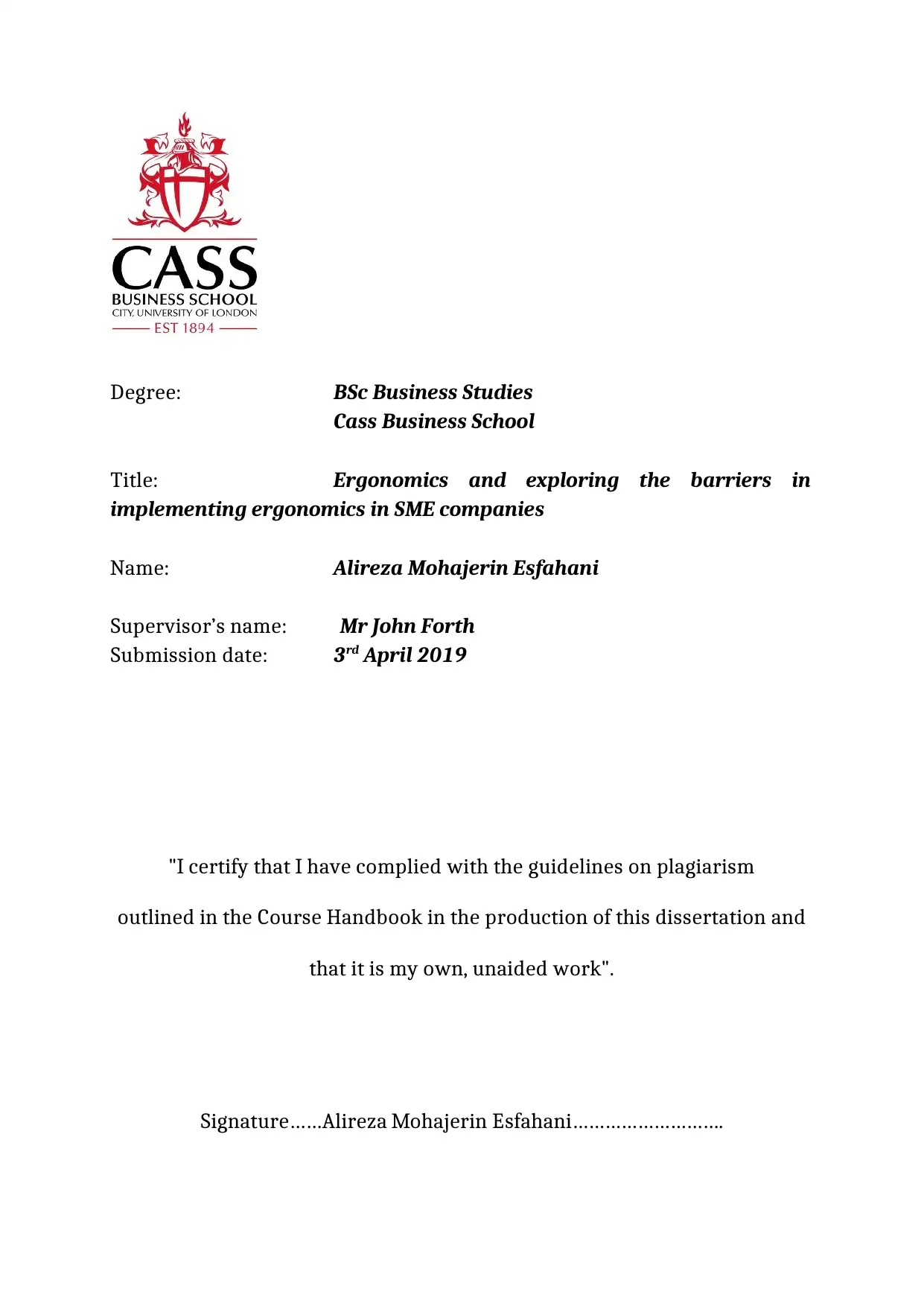
Degree: BSc Business Studies
Cass Business School
Title: Ergonomics and exploring the barriers in
implementing ergonomics in SME companies
Name: Alireza Mohajerin Esfahani
Supervisor’s name: Mr John Forth
Submission date: 3rd April 2019
"I certify that I have complied with the guidelines on plagiarism
outlined in the Course Handbook in the production of this dissertation and
that it is my own, unaided work".
Signature……Alireza Mohajerin Esfahani……………………….
Cass Business School
Title: Ergonomics and exploring the barriers in
implementing ergonomics in SME companies
Name: Alireza Mohajerin Esfahani
Supervisor’s name: Mr John Forth
Submission date: 3rd April 2019
"I certify that I have complied with the guidelines on plagiarism
outlined in the Course Handbook in the production of this dissertation and
that it is my own, unaided work".
Signature……Alireza Mohajerin Esfahani……………………….
Paraphrase This Document
Need a fresh take? Get an instant paraphrase of this document with our AI Paraphraser
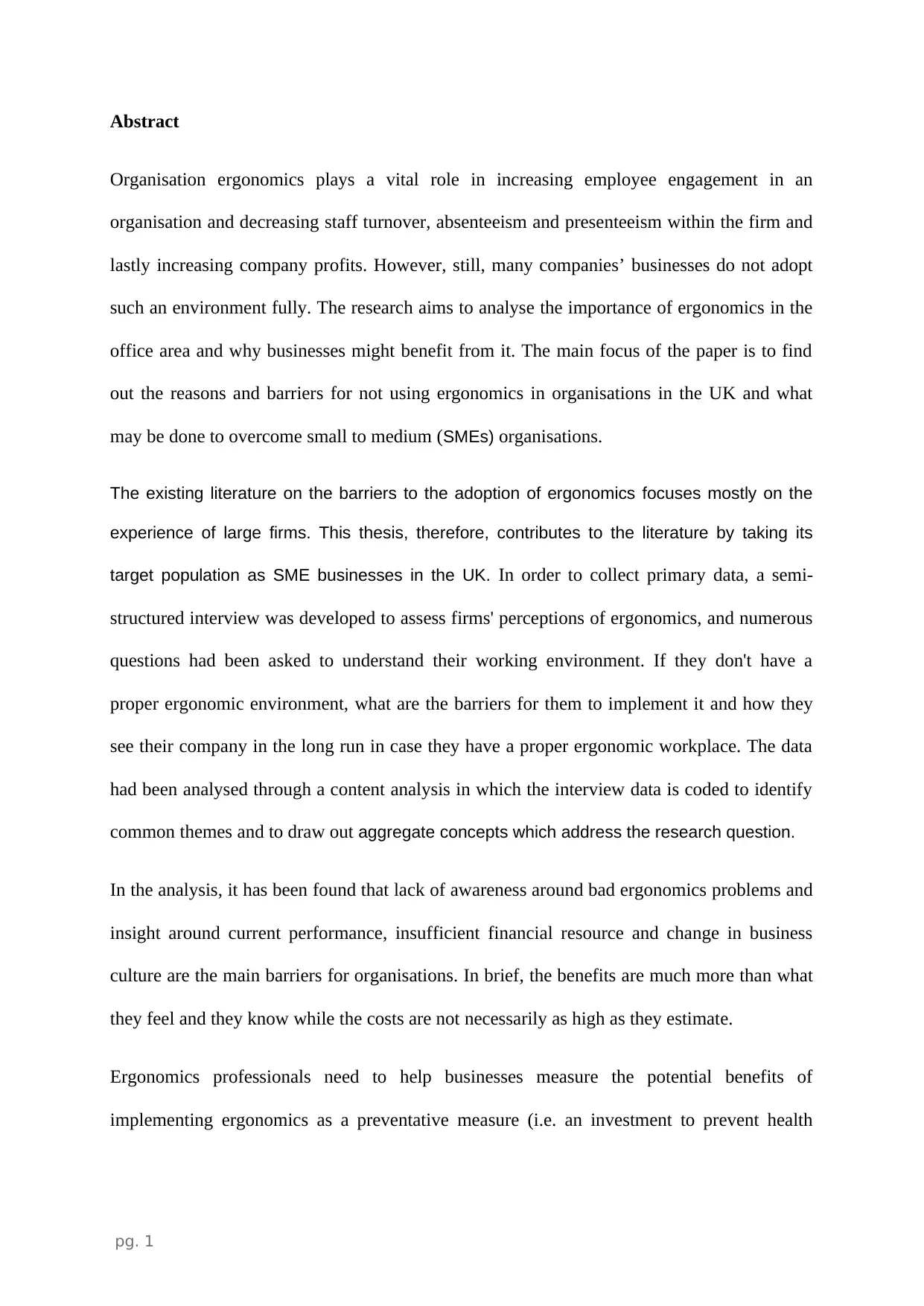
Abstract
Organisation ergonomics plays a vital role in increasing employee engagement in an
organisation and decreasing staff turnover, absenteeism and presenteeism within the firm and
lastly increasing company profits. However, still, many companies’ businesses do not adopt
such an environment fully. The research aims to analyse the importance of ergonomics in the
office area and why businesses might benefit from it. The main focus of the paper is to find
out the reasons and barriers for not using ergonomics in organisations in the UK and what
may be done to overcome small to medium (SMEs) organisations.
The existing literature on the barriers to the adoption of ergonomics focuses mostly on the
experience of large firms. This thesis, therefore, contributes to the literature by taking its
target population as SME businesses in the UK. In order to collect primary data, a semi-
structured interview was developed to assess firms' perceptions of ergonomics, and numerous
questions had been asked to understand their working environment. If they don't have a
proper ergonomic environment, what are the barriers for them to implement it and how they
see their company in the long run in case they have a proper ergonomic workplace. The data
had been analysed through a content analysis in which the interview data is coded to identify
common themes and to draw out aggregate concepts which address the research question.
In the analysis, it has been found that lack of awareness around bad ergonomics problems and
insight around current performance, insufficient financial resource and change in business
culture are the main barriers for organisations. In brief, the benefits are much more than what
they feel and they know while the costs are not necessarily as high as they estimate.
Ergonomics professionals need to help businesses measure the potential benefits of
implementing ergonomics as a preventative measure (i.e. an investment to prevent health
pg. 1
Organisation ergonomics plays a vital role in increasing employee engagement in an
organisation and decreasing staff turnover, absenteeism and presenteeism within the firm and
lastly increasing company profits. However, still, many companies’ businesses do not adopt
such an environment fully. The research aims to analyse the importance of ergonomics in the
office area and why businesses might benefit from it. The main focus of the paper is to find
out the reasons and barriers for not using ergonomics in organisations in the UK and what
may be done to overcome small to medium (SMEs) organisations.
The existing literature on the barriers to the adoption of ergonomics focuses mostly on the
experience of large firms. This thesis, therefore, contributes to the literature by taking its
target population as SME businesses in the UK. In order to collect primary data, a semi-
structured interview was developed to assess firms' perceptions of ergonomics, and numerous
questions had been asked to understand their working environment. If they don't have a
proper ergonomic environment, what are the barriers for them to implement it and how they
see their company in the long run in case they have a proper ergonomic workplace. The data
had been analysed through a content analysis in which the interview data is coded to identify
common themes and to draw out aggregate concepts which address the research question.
In the analysis, it has been found that lack of awareness around bad ergonomics problems and
insight around current performance, insufficient financial resource and change in business
culture are the main barriers for organisations. In brief, the benefits are much more than what
they feel and they know while the costs are not necessarily as high as they estimate.
Ergonomics professionals need to help businesses measure the potential benefits of
implementing ergonomics as a preventative measure (i.e. an investment to prevent health
pg. 1

problems and increase employee concentration), rather than seeing it as a health-focused
intervention (a cost) when an employee gets ill.
pg. 2
intervention (a cost) when an employee gets ill.
pg. 2
⊘ This is a preview!⊘
Do you want full access?
Subscribe today to unlock all pages.

Trusted by 1+ million students worldwide

Table of Content
Acknowledgements................................................................................................................... 4
Introduction.............................................................................................................................. 5
The problems caused by a poor working environment................................................................5
Significance of Ergonomics....................................................................................................7
What do we know about the barriers to implementation?............................................................7
Literature Review......................................................................................................................9
Introduction........................................................................................................................... 9
The costs of a non-ergonomic workplace environment.............................................................10
The Advantages of Ergonomics.............................................................................................12
Factors and barriers in implementing Ergonomics....................................................................13
Gaps in the literature............................................................................................................ 15
Summary............................................................................................................................ 15
Methodology........................................................................................................................... 17
Introduction......................................................................................................................... 17
Research Approach and Justification......................................................................................17
Data collection process.........................................................................................................18
Target Sample and justification.............................................................................................20
Data analysis process and Justification...................................................................................21
Limitation of Methodology...................................................................................................21
Empirical analysis and findings.................................................................................................23
4.1 Insufficient Financial Resource........................................................................................23
pg. 3
Acknowledgements................................................................................................................... 4
Introduction.............................................................................................................................. 5
The problems caused by a poor working environment................................................................5
Significance of Ergonomics....................................................................................................7
What do we know about the barriers to implementation?............................................................7
Literature Review......................................................................................................................9
Introduction........................................................................................................................... 9
The costs of a non-ergonomic workplace environment.............................................................10
The Advantages of Ergonomics.............................................................................................12
Factors and barriers in implementing Ergonomics....................................................................13
Gaps in the literature............................................................................................................ 15
Summary............................................................................................................................ 15
Methodology........................................................................................................................... 17
Introduction......................................................................................................................... 17
Research Approach and Justification......................................................................................17
Data collection process.........................................................................................................18
Target Sample and justification.............................................................................................20
Data analysis process and Justification...................................................................................21
Limitation of Methodology...................................................................................................21
Empirical analysis and findings.................................................................................................23
4.1 Insufficient Financial Resource........................................................................................23
pg. 3
Paraphrase This Document
Need a fresh take? Get an instant paraphrase of this document with our AI Paraphraser
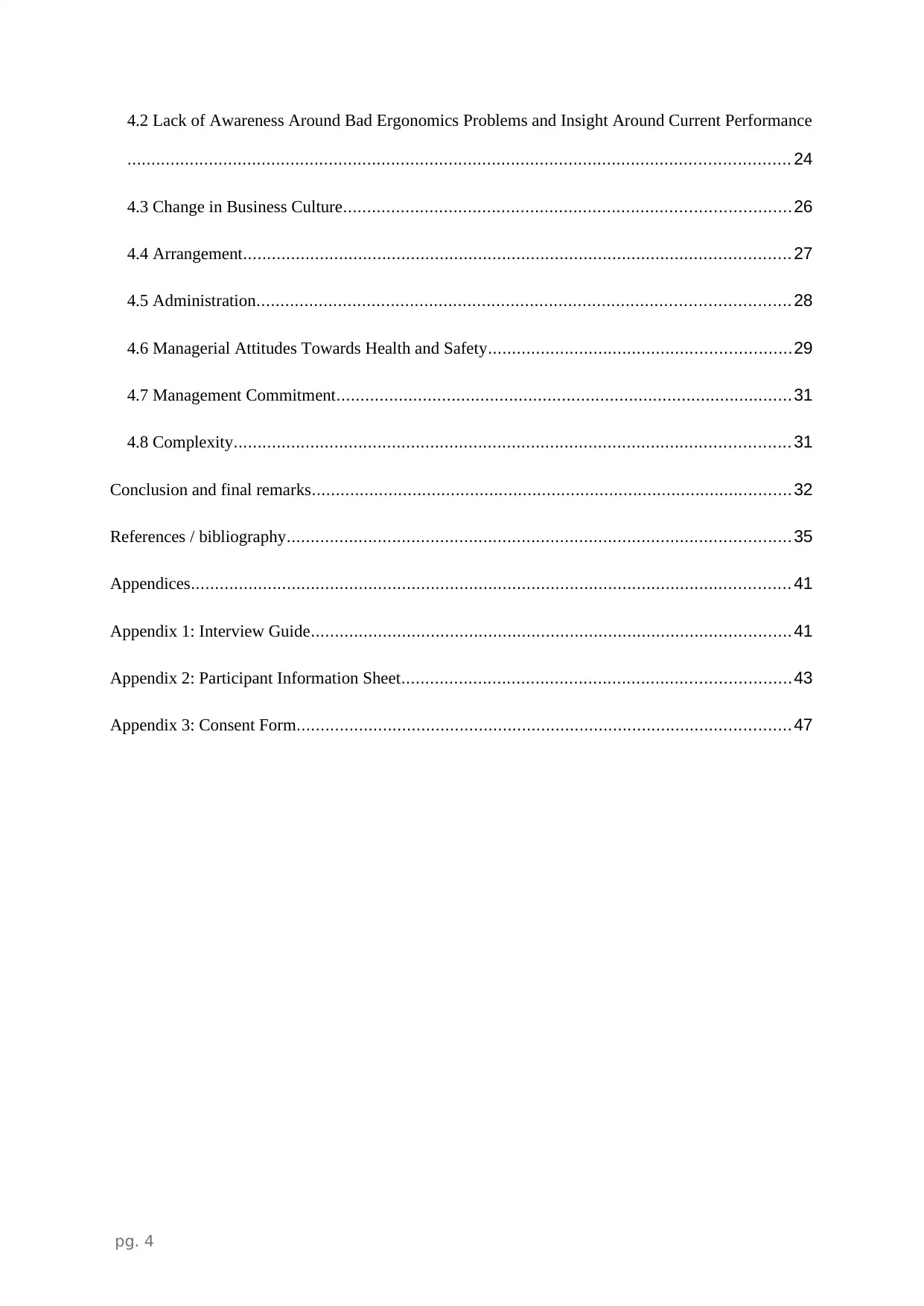
4.2 Lack of Awareness Around Bad Ergonomics Problems and Insight Around Current Performance
.......................................................................................................................................... 24
4.3 Change in Business Culture.............................................................................................26
4.4 Arrangement.................................................................................................................. 27
4.5 Administration............................................................................................................... 28
4.6 Managerial Attitudes Towards Health and Safety...............................................................29
4.7 Management Commitment...............................................................................................31
4.8 Complexity.................................................................................................................... 31
Conclusion and final remarks....................................................................................................32
References / bibliography.........................................................................................................35
Appendices............................................................................................................................. 41
Appendix 1: Interview Guide....................................................................................................41
Appendix 2: Participant Information Sheet.................................................................................43
Appendix 3: Consent Form.......................................................................................................47
pg. 4
.......................................................................................................................................... 24
4.3 Change in Business Culture.............................................................................................26
4.4 Arrangement.................................................................................................................. 27
4.5 Administration............................................................................................................... 28
4.6 Managerial Attitudes Towards Health and Safety...............................................................29
4.7 Management Commitment...............................................................................................31
4.8 Complexity.................................................................................................................... 31
Conclusion and final remarks....................................................................................................32
References / bibliography.........................................................................................................35
Appendices............................................................................................................................. 41
Appendix 1: Interview Guide....................................................................................................41
Appendix 2: Participant Information Sheet.................................................................................43
Appendix 3: Consent Form.......................................................................................................47
pg. 4

Acknowledgements
Firstly, I would like to thank Mr John Forth for his support and guidance during the project
and reassurance throughout my studies.
Secondly, I would like to thank all of the participants in my research interview, for their time
and expertise that has allowed me to undertake this research.
Lastly, I would like to thank my family for their unconditional love, support and
encouragement during my studies.
Thank you all.
pg. 5
Firstly, I would like to thank Mr John Forth for his support and guidance during the project
and reassurance throughout my studies.
Secondly, I would like to thank all of the participants in my research interview, for their time
and expertise that has allowed me to undertake this research.
Lastly, I would like to thank my family for their unconditional love, support and
encouragement during my studies.
Thank you all.
pg. 5
⊘ This is a preview!⊘
Do you want full access?
Subscribe today to unlock all pages.

Trusted by 1+ million students worldwide
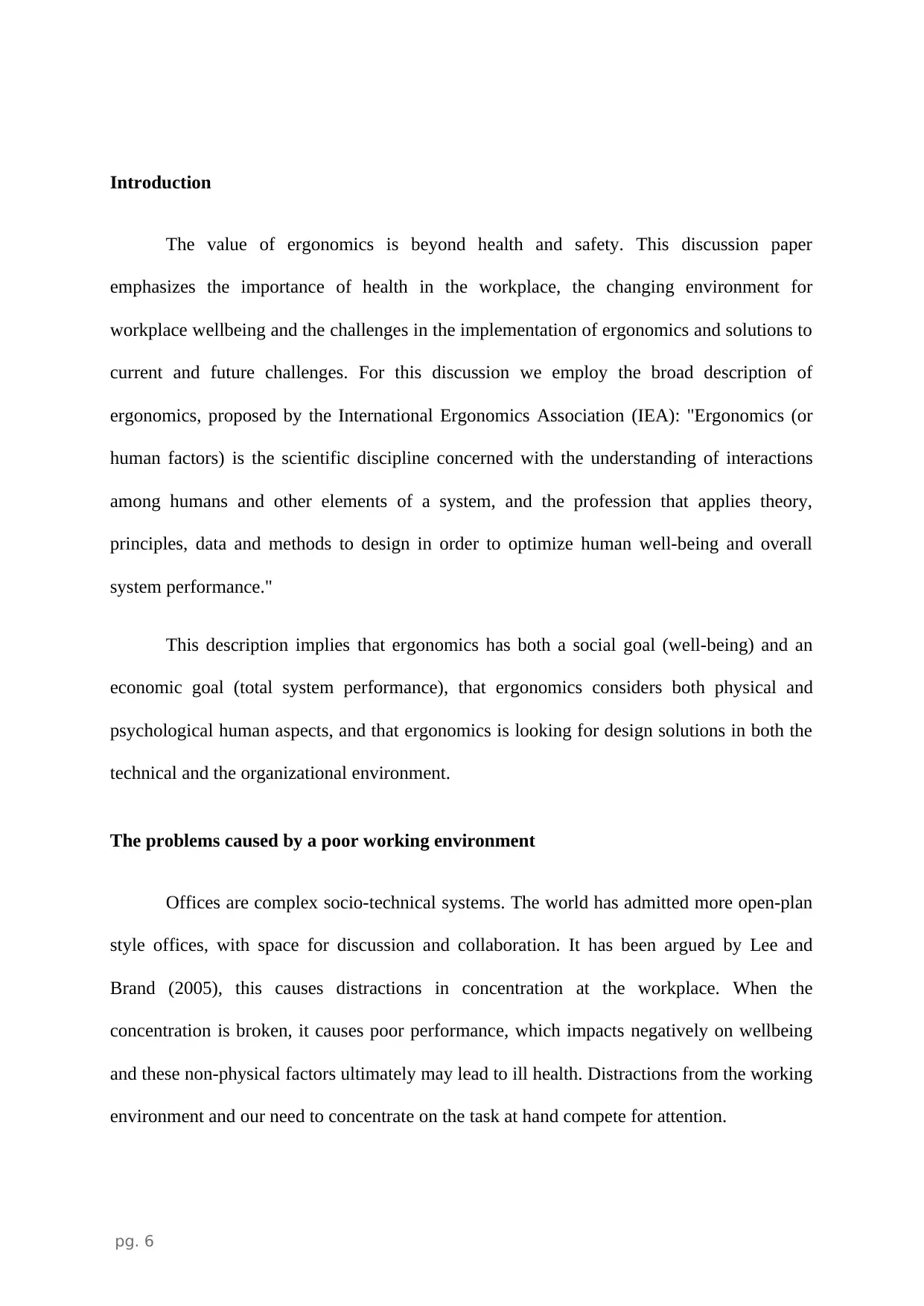
Introduction
The value of ergonomics is beyond health and safety. This discussion paper
emphasizes the importance of health in the workplace, the changing environment for
workplace wellbeing and the challenges in the implementation of ergonomics and solutions to
current and future challenges. For this discussion we employ the broad description of
ergonomics, proposed by the International Ergonomics Association (IEA): "Ergonomics (or
human factors) is the scientific discipline concerned with the understanding of interactions
among humans and other elements of a system, and the profession that applies theory,
principles, data and methods to design in order to optimize human well-being and overall
system performance."
This description implies that ergonomics has both a social goal (well-being) and an
economic goal (total system performance), that ergonomics considers both physical and
psychological human aspects, and that ergonomics is looking for design solutions in both the
technical and the organizational environment.
The problems caused by a poor working environment
Offices are complex socio-technical systems. The world has admitted more open-plan
style offices, with space for discussion and collaboration. It has been argued by Lee and
Brand (2005), this causes distractions in concentration at the workplace. When the
concentration is broken, it causes poor performance, which impacts negatively on wellbeing
and these non-physical factors ultimately may lead to ill health. Distractions from the working
environment and our need to concentrate on the task at hand compete for attention.
pg. 6
The value of ergonomics is beyond health and safety. This discussion paper
emphasizes the importance of health in the workplace, the changing environment for
workplace wellbeing and the challenges in the implementation of ergonomics and solutions to
current and future challenges. For this discussion we employ the broad description of
ergonomics, proposed by the International Ergonomics Association (IEA): "Ergonomics (or
human factors) is the scientific discipline concerned with the understanding of interactions
among humans and other elements of a system, and the profession that applies theory,
principles, data and methods to design in order to optimize human well-being and overall
system performance."
This description implies that ergonomics has both a social goal (well-being) and an
economic goal (total system performance), that ergonomics considers both physical and
psychological human aspects, and that ergonomics is looking for design solutions in both the
technical and the organizational environment.
The problems caused by a poor working environment
Offices are complex socio-technical systems. The world has admitted more open-plan
style offices, with space for discussion and collaboration. It has been argued by Lee and
Brand (2005), this causes distractions in concentration at the workplace. When the
concentration is broken, it causes poor performance, which impacts negatively on wellbeing
and these non-physical factors ultimately may lead to ill health. Distractions from the working
environment and our need to concentrate on the task at hand compete for attention.
pg. 6
Paraphrase This Document
Need a fresh take? Get an instant paraphrase of this document with our AI Paraphraser
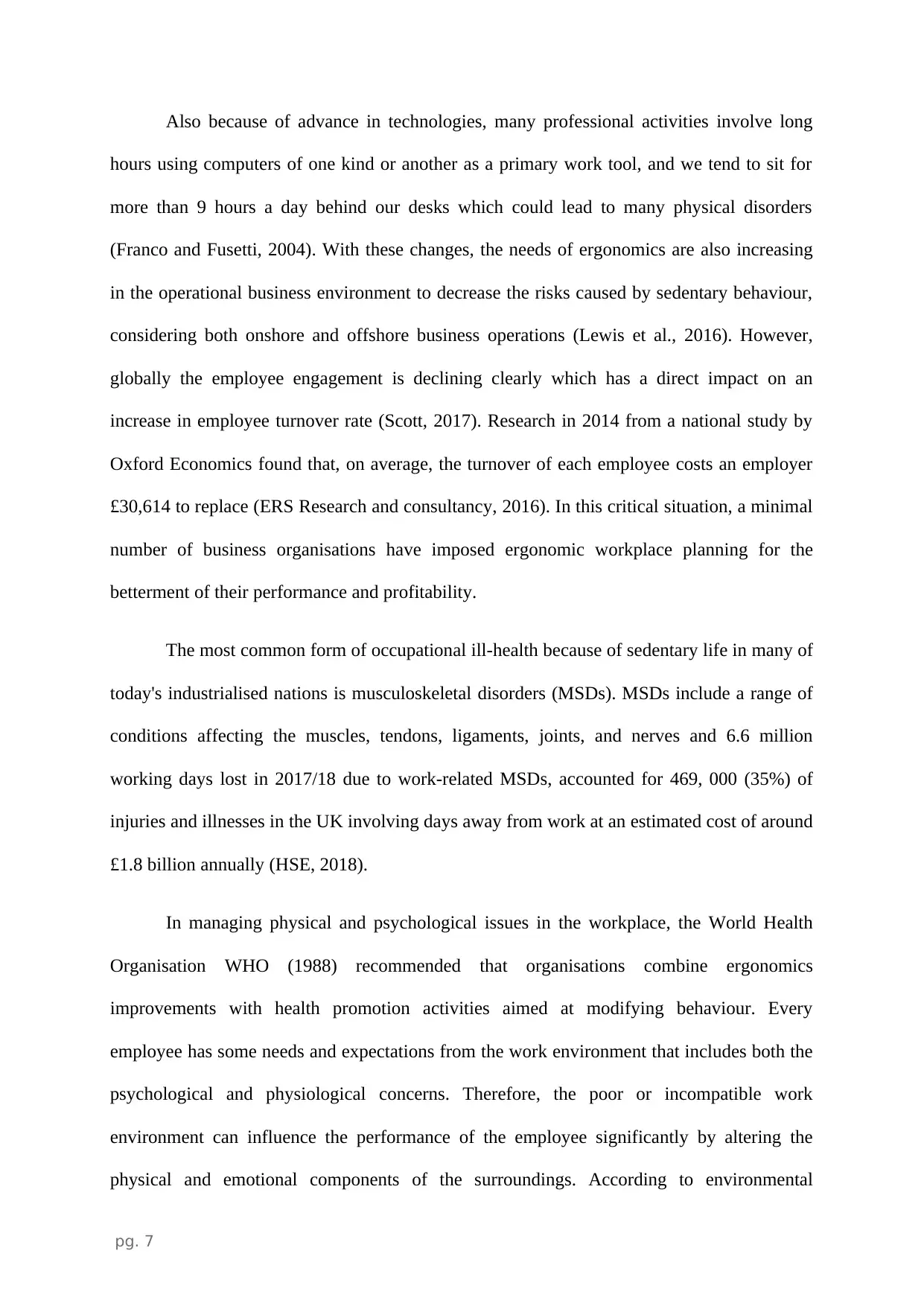
Also because of advance in technologies, many professional activities involve long
hours using computers of one kind or another as a primary work tool, and we tend to sit for
more than 9 hours a day behind our desks which could lead to many physical disorders
(Franco and Fusetti, 2004). With these changes, the needs of ergonomics are also increasing
in the operational business environment to decrease the risks caused by sedentary behaviour,
considering both onshore and offshore business operations (Lewis et al., 2016). However,
globally the employee engagement is declining clearly which has a direct impact on an
increase in employee turnover rate (Scott, 2017). Research in 2014 from a national study by
Oxford Economics found that, on average, the turnover of each employee costs an employer
£30,614 to replace (ERS Research and consultancy, 2016). In this critical situation, a minimal
number of business organisations have imposed ergonomic workplace planning for the
betterment of their performance and profitability.
The most common form of occupational ill-health because of sedentary life in many of
today's industrialised nations is musculoskeletal disorders (MSDs). MSDs include a range of
conditions affecting the muscles, tendons, ligaments, joints, and nerves and 6.6 million
working days lost in 2017/18 due to work-related MSDs, accounted for 469, 000 (35%) of
injuries and illnesses in the UK involving days away from work at an estimated cost of around
£1.8 billion annually (HSE, 2018).
In managing physical and psychological issues in the workplace, the World Health
Organisation WHO (1988) recommended that organisations combine ergonomics
improvements with health promotion activities aimed at modifying behaviour. Every
employee has some needs and expectations from the work environment that includes both the
psychological and physiological concerns. Therefore, the poor or incompatible work
environment can influence the performance of the employee significantly by altering the
physical and emotional components of the surroundings. According to environmental
pg. 7
hours using computers of one kind or another as a primary work tool, and we tend to sit for
more than 9 hours a day behind our desks which could lead to many physical disorders
(Franco and Fusetti, 2004). With these changes, the needs of ergonomics are also increasing
in the operational business environment to decrease the risks caused by sedentary behaviour,
considering both onshore and offshore business operations (Lewis et al., 2016). However,
globally the employee engagement is declining clearly which has a direct impact on an
increase in employee turnover rate (Scott, 2017). Research in 2014 from a national study by
Oxford Economics found that, on average, the turnover of each employee costs an employer
£30,614 to replace (ERS Research and consultancy, 2016). In this critical situation, a minimal
number of business organisations have imposed ergonomic workplace planning for the
betterment of their performance and profitability.
The most common form of occupational ill-health because of sedentary life in many of
today's industrialised nations is musculoskeletal disorders (MSDs). MSDs include a range of
conditions affecting the muscles, tendons, ligaments, joints, and nerves and 6.6 million
working days lost in 2017/18 due to work-related MSDs, accounted for 469, 000 (35%) of
injuries and illnesses in the UK involving days away from work at an estimated cost of around
£1.8 billion annually (HSE, 2018).
In managing physical and psychological issues in the workplace, the World Health
Organisation WHO (1988) recommended that organisations combine ergonomics
improvements with health promotion activities aimed at modifying behaviour. Every
employee has some needs and expectations from the work environment that includes both the
psychological and physiological concerns. Therefore, the poor or incompatible work
environment can influence the performance of the employee significantly by altering the
physical and emotional components of the surroundings. According to environmental
pg. 7
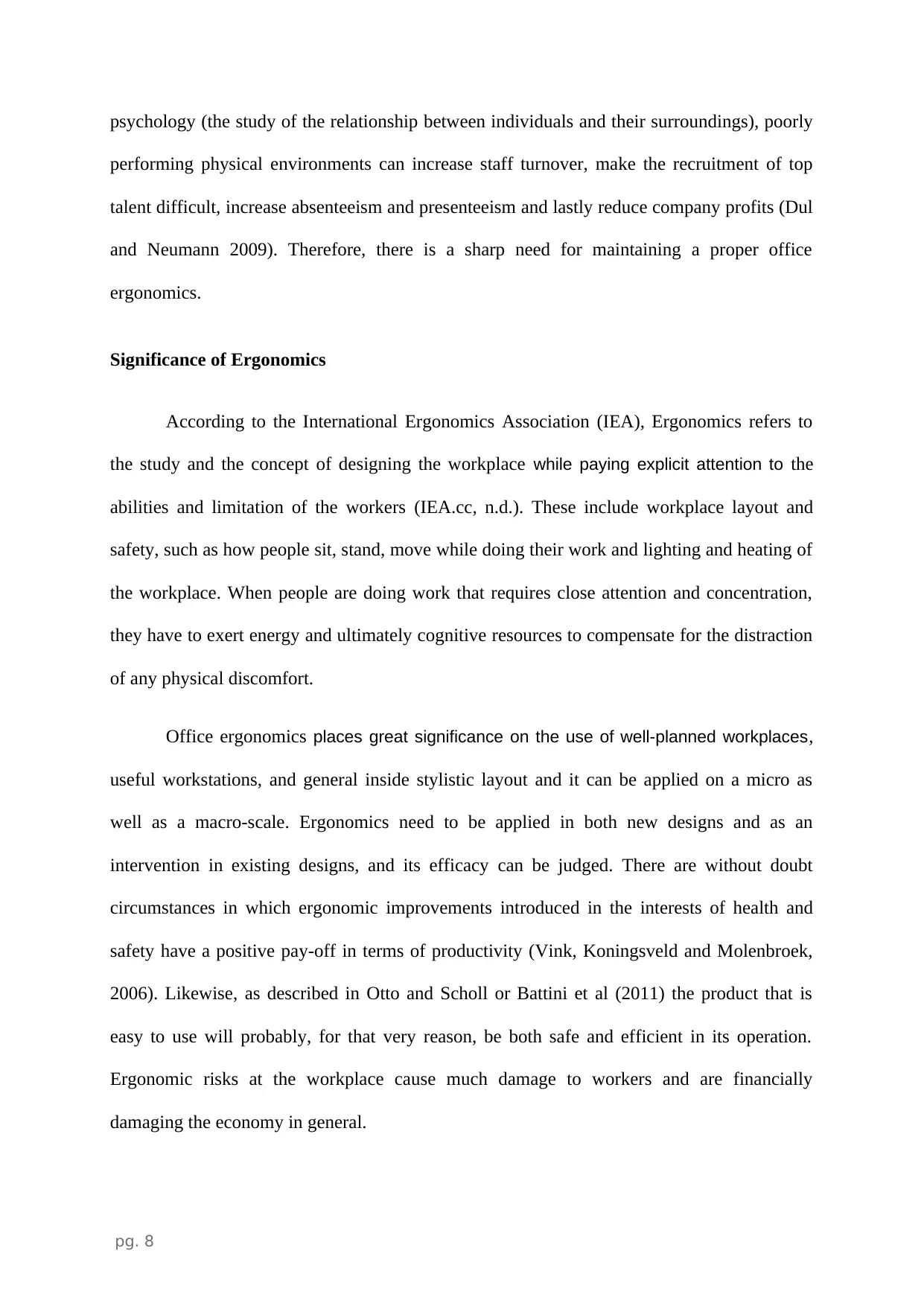
psychology (the study of the relationship between individuals and their surroundings), poorly
performing physical environments can increase staff turnover, make the recruitment of top
talent difficult, increase absenteeism and presenteeism and lastly reduce company profits (Dul
and Neumann 2009). Therefore, there is a sharp need for maintaining a proper office
ergonomics.
Significance of Ergonomics
According to the International Ergonomics Association (IEA), Ergonomics refers to
the study and the concept of designing the workplace while paying explicit attention to the
abilities and limitation of the workers (IEA.cc, n.d.). These include workplace layout and
safety, such as how people sit, stand, move while doing their work and lighting and heating of
the workplace. When people are doing work that requires close attention and concentration,
they have to exert energy and ultimately cognitive resources to compensate for the distraction
of any physical discomfort.
Office ergonomics places great significance on the use of well-planned workplaces,
useful workstations, and general inside stylistic layout and it can be applied on a micro as
well as a macro-scale. Ergonomics need to be applied in both new designs and as an
intervention in existing designs, and its efficacy can be judged. There are without doubt
circumstances in which ergonomic improvements introduced in the interests of health and
safety have a positive pay-off in terms of productivity (Vink, Koningsveld and Molenbroek,
2006). Likewise, as described in Otto and Scholl or Battini et al (2011) the product that is
easy to use will probably, for that very reason, be both safe and efficient in its operation.
Ergonomic risks at the workplace cause much damage to workers and are financially
damaging the economy in general.
pg. 8
performing physical environments can increase staff turnover, make the recruitment of top
talent difficult, increase absenteeism and presenteeism and lastly reduce company profits (Dul
and Neumann 2009). Therefore, there is a sharp need for maintaining a proper office
ergonomics.
Significance of Ergonomics
According to the International Ergonomics Association (IEA), Ergonomics refers to
the study and the concept of designing the workplace while paying explicit attention to the
abilities and limitation of the workers (IEA.cc, n.d.). These include workplace layout and
safety, such as how people sit, stand, move while doing their work and lighting and heating of
the workplace. When people are doing work that requires close attention and concentration,
they have to exert energy and ultimately cognitive resources to compensate for the distraction
of any physical discomfort.
Office ergonomics places great significance on the use of well-planned workplaces,
useful workstations, and general inside stylistic layout and it can be applied on a micro as
well as a macro-scale. Ergonomics need to be applied in both new designs and as an
intervention in existing designs, and its efficacy can be judged. There are without doubt
circumstances in which ergonomic improvements introduced in the interests of health and
safety have a positive pay-off in terms of productivity (Vink, Koningsveld and Molenbroek,
2006). Likewise, as described in Otto and Scholl or Battini et al (2011) the product that is
easy to use will probably, for that very reason, be both safe and efficient in its operation.
Ergonomic risks at the workplace cause much damage to workers and are financially
damaging the economy in general.
pg. 8
⊘ This is a preview!⊘
Do you want full access?
Subscribe today to unlock all pages.

Trusted by 1+ million students worldwide
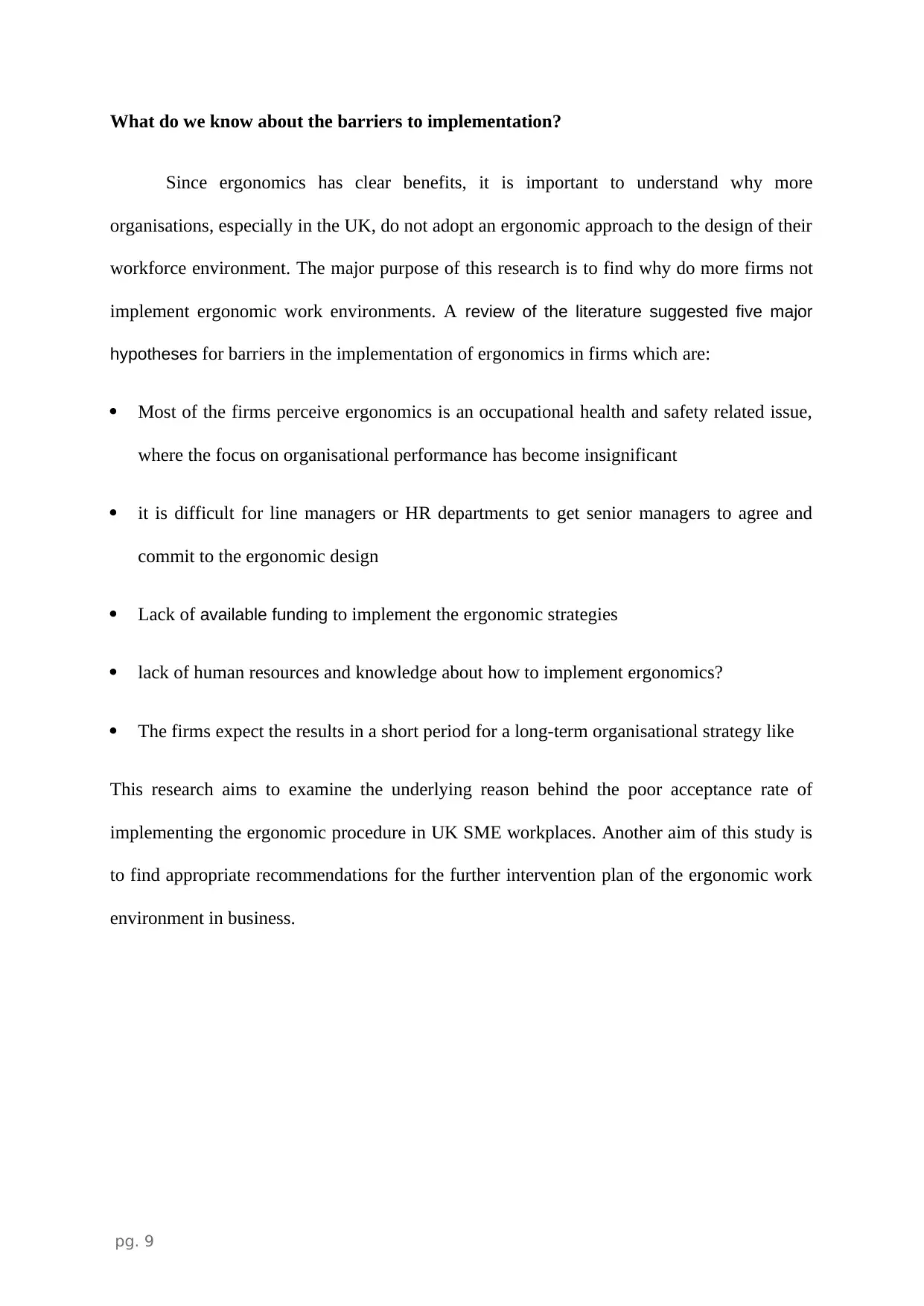
What do we know about the barriers to implementation?
Since ergonomics has clear benefits, it is important to understand why more
organisations, especially in the UK, do not adopt an ergonomic approach to the design of their
workforce environment. The major purpose of this research is to find why do more firms not
implement ergonomic work environments. A review of the literature suggested five major
hypotheses for barriers in the implementation of ergonomics in firms which are:
Most of the firms perceive ergonomics is an occupational health and safety related issue,
where the focus on organisational performance has become insignificant
it is difficult for line managers or HR departments to get senior managers to agree and
commit to the ergonomic design
Lack of available funding to implement the ergonomic strategies
lack of human resources and knowledge about how to implement ergonomics?
The firms expect the results in a short period for a long-term organisational strategy like
This research aims to examine the underlying reason behind the poor acceptance rate of
implementing the ergonomic procedure in UK SME workplaces. Another aim of this study is
to find appropriate recommendations for the further intervention plan of the ergonomic work
environment in business.
pg. 9
Since ergonomics has clear benefits, it is important to understand why more
organisations, especially in the UK, do not adopt an ergonomic approach to the design of their
workforce environment. The major purpose of this research is to find why do more firms not
implement ergonomic work environments. A review of the literature suggested five major
hypotheses for barriers in the implementation of ergonomics in firms which are:
Most of the firms perceive ergonomics is an occupational health and safety related issue,
where the focus on organisational performance has become insignificant
it is difficult for line managers or HR departments to get senior managers to agree and
commit to the ergonomic design
Lack of available funding to implement the ergonomic strategies
lack of human resources and knowledge about how to implement ergonomics?
The firms expect the results in a short period for a long-term organisational strategy like
This research aims to examine the underlying reason behind the poor acceptance rate of
implementing the ergonomic procedure in UK SME workplaces. Another aim of this study is
to find appropriate recommendations for the further intervention plan of the ergonomic work
environment in business.
pg. 9
Paraphrase This Document
Need a fresh take? Get an instant paraphrase of this document with our AI Paraphraser
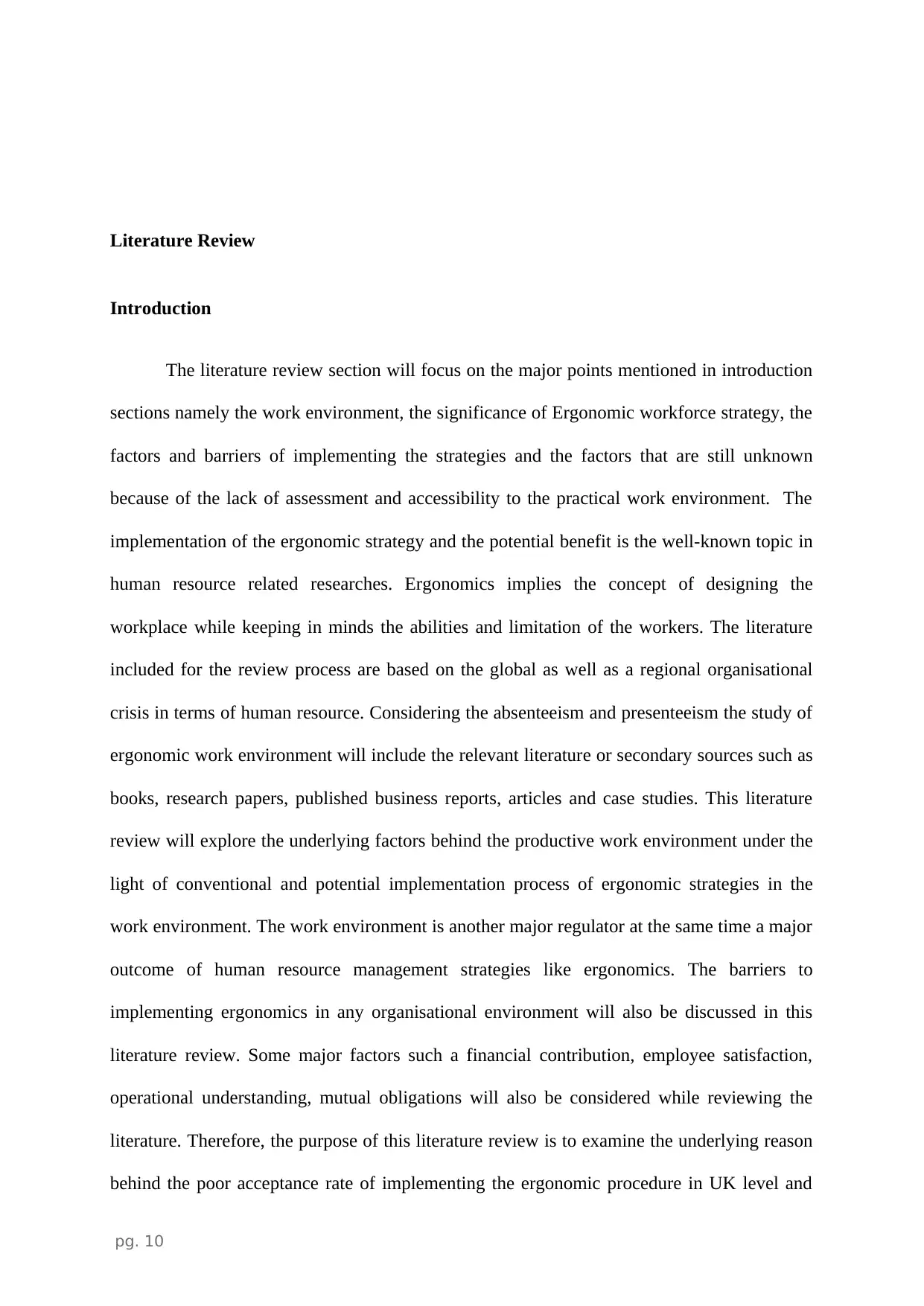
Literature Review
Introduction
The literature review section will focus on the major points mentioned in introduction
sections namely the work environment, the significance of Ergonomic workforce strategy, the
factors and barriers of implementing the strategies and the factors that are still unknown
because of the lack of assessment and accessibility to the practical work environment. The
implementation of the ergonomic strategy and the potential benefit is the well-known topic in
human resource related researches. Ergonomics implies the concept of designing the
workplace while keeping in minds the abilities and limitation of the workers. The literature
included for the review process are based on the global as well as a regional organisational
crisis in terms of human resource. Considering the absenteeism and presenteeism the study of
ergonomic work environment will include the relevant literature or secondary sources such as
books, research papers, published business reports, articles and case studies. This literature
review will explore the underlying factors behind the productive work environment under the
light of conventional and potential implementation process of ergonomic strategies in the
work environment. The work environment is another major regulator at the same time a major
outcome of human resource management strategies like ergonomics. The barriers to
implementing ergonomics in any organisational environment will also be discussed in this
literature review. Some major factors such a financial contribution, employee satisfaction,
operational understanding, mutual obligations will also be considered while reviewing the
literature. Therefore, the purpose of this literature review is to examine the underlying reason
behind the poor acceptance rate of implementing the ergonomic procedure in UK level and
pg. 10
Introduction
The literature review section will focus on the major points mentioned in introduction
sections namely the work environment, the significance of Ergonomic workforce strategy, the
factors and barriers of implementing the strategies and the factors that are still unknown
because of the lack of assessment and accessibility to the practical work environment. The
implementation of the ergonomic strategy and the potential benefit is the well-known topic in
human resource related researches. Ergonomics implies the concept of designing the
workplace while keeping in minds the abilities and limitation of the workers. The literature
included for the review process are based on the global as well as a regional organisational
crisis in terms of human resource. Considering the absenteeism and presenteeism the study of
ergonomic work environment will include the relevant literature or secondary sources such as
books, research papers, published business reports, articles and case studies. This literature
review will explore the underlying factors behind the productive work environment under the
light of conventional and potential implementation process of ergonomic strategies in the
work environment. The work environment is another major regulator at the same time a major
outcome of human resource management strategies like ergonomics. The barriers to
implementing ergonomics in any organisational environment will also be discussed in this
literature review. Some major factors such a financial contribution, employee satisfaction,
operational understanding, mutual obligations will also be considered while reviewing the
literature. Therefore, the purpose of this literature review is to examine the underlying reason
behind the poor acceptance rate of implementing the ergonomic procedure in UK level and
pg. 10
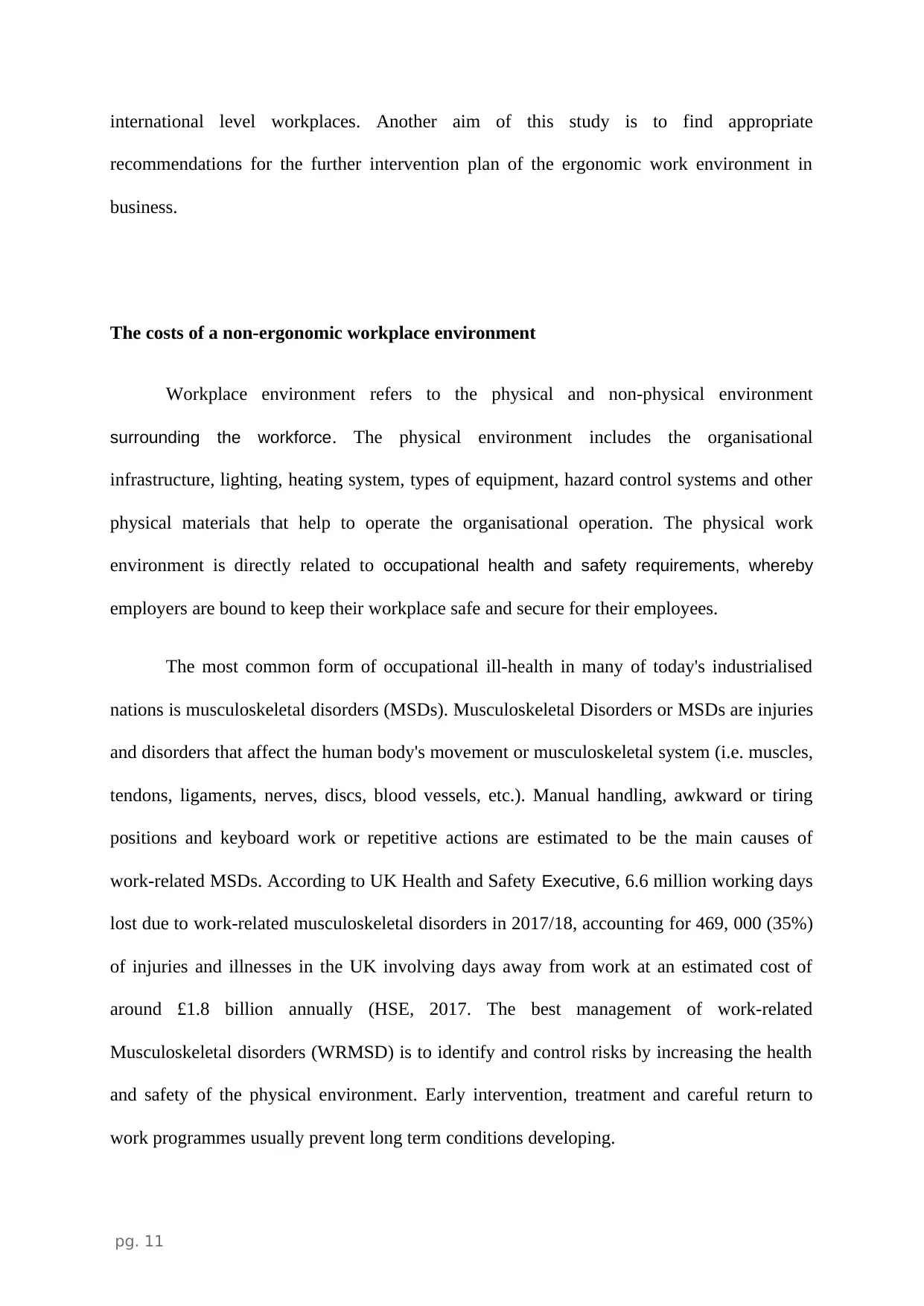
international level workplaces. Another aim of this study is to find appropriate
recommendations for the further intervention plan of the ergonomic work environment in
business.
The costs of a non-ergonomic workplace environment
Workplace environment refers to the physical and non-physical environment
surrounding the workforce. The physical environment includes the organisational
infrastructure, lighting, heating system, types of equipment, hazard control systems and other
physical materials that help to operate the organisational operation. The physical work
environment is directly related to occupational health and safety requirements, whereby
employers are bound to keep their workplace safe and secure for their employees.
The most common form of occupational ill-health in many of today's industrialised
nations is musculoskeletal disorders (MSDs). Musculoskeletal Disorders or MSDs are injuries
and disorders that affect the human body's movement or musculoskeletal system (i.e. muscles,
tendons, ligaments, nerves, discs, blood vessels, etc.). Manual handling, awkward or tiring
positions and keyboard work or repetitive actions are estimated to be the main causes of
work-related MSDs. According to UK Health and Safety Executive, 6.6 million working days
lost due to work-related musculoskeletal disorders in 2017/18, accounting for 469, 000 (35%)
of injuries and illnesses in the UK involving days away from work at an estimated cost of
around £1.8 billion annually (HSE, 2017. The best management of work-related
Musculoskeletal disorders (WRMSD) is to identify and control risks by increasing the health
and safety of the physical environment. Early intervention, treatment and careful return to
work programmes usually prevent long term conditions developing.
pg. 11
recommendations for the further intervention plan of the ergonomic work environment in
business.
The costs of a non-ergonomic workplace environment
Workplace environment refers to the physical and non-physical environment
surrounding the workforce. The physical environment includes the organisational
infrastructure, lighting, heating system, types of equipment, hazard control systems and other
physical materials that help to operate the organisational operation. The physical work
environment is directly related to occupational health and safety requirements, whereby
employers are bound to keep their workplace safe and secure for their employees.
The most common form of occupational ill-health in many of today's industrialised
nations is musculoskeletal disorders (MSDs). Musculoskeletal Disorders or MSDs are injuries
and disorders that affect the human body's movement or musculoskeletal system (i.e. muscles,
tendons, ligaments, nerves, discs, blood vessels, etc.). Manual handling, awkward or tiring
positions and keyboard work or repetitive actions are estimated to be the main causes of
work-related MSDs. According to UK Health and Safety Executive, 6.6 million working days
lost due to work-related musculoskeletal disorders in 2017/18, accounting for 469, 000 (35%)
of injuries and illnesses in the UK involving days away from work at an estimated cost of
around £1.8 billion annually (HSE, 2017. The best management of work-related
Musculoskeletal disorders (WRMSD) is to identify and control risks by increasing the health
and safety of the physical environment. Early intervention, treatment and careful return to
work programmes usually prevent long term conditions developing.
pg. 11
⊘ This is a preview!⊘
Do you want full access?
Subscribe today to unlock all pages.

Trusted by 1+ million students worldwide
1 out of 51
Related Documents
Your All-in-One AI-Powered Toolkit for Academic Success.
+13062052269
info@desklib.com
Available 24*7 on WhatsApp / Email
![[object Object]](/_next/static/media/star-bottom.7253800d.svg)
Unlock your academic potential
Copyright © 2020–2025 A2Z Services. All Rights Reserved. Developed and managed by ZUCOL.





